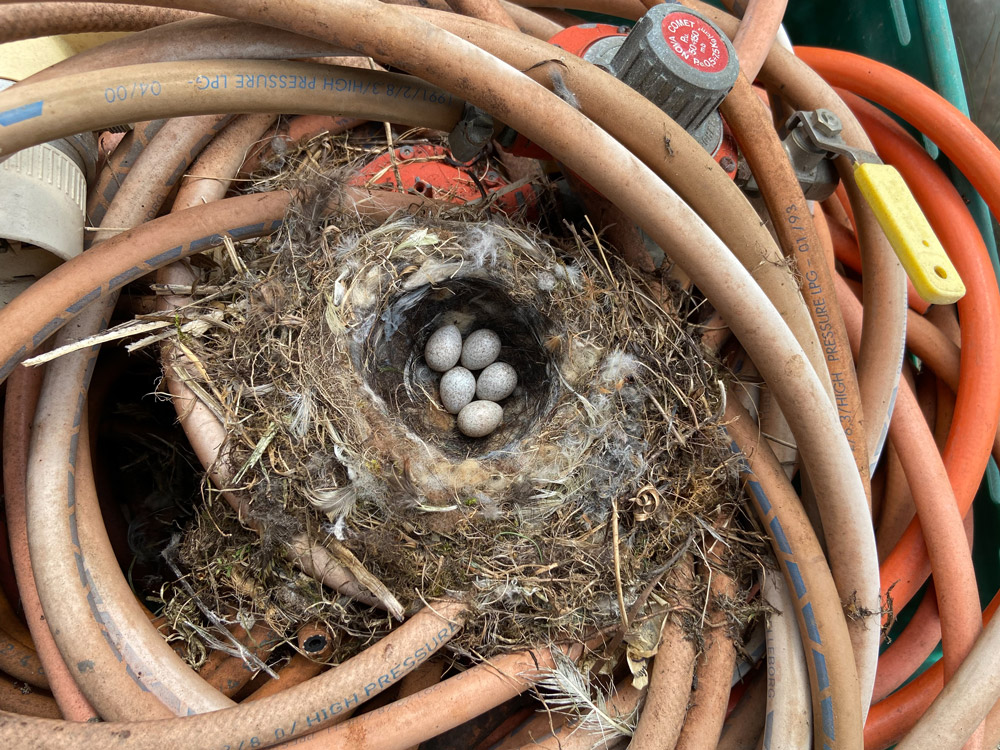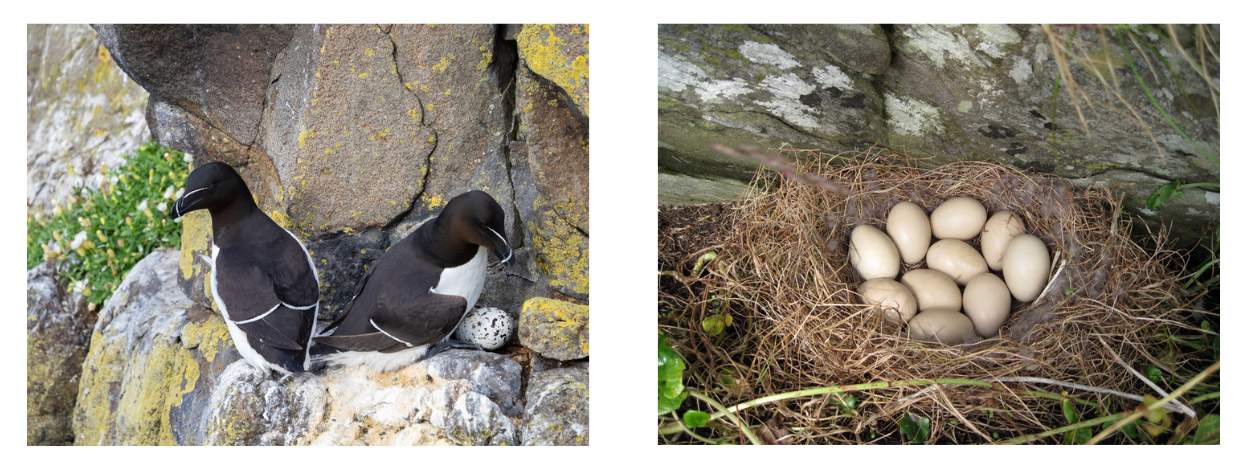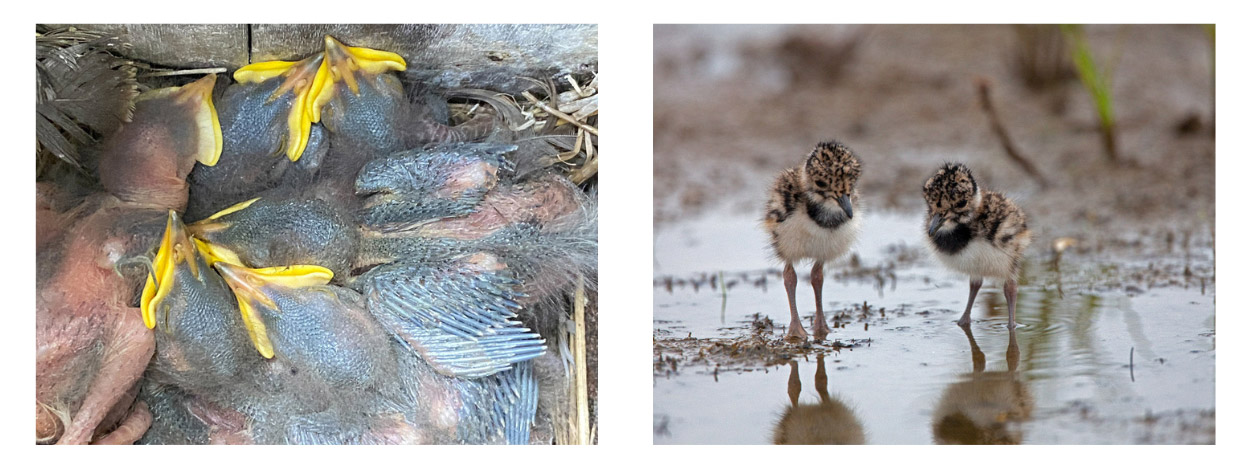Biology
Productivity and nesting
Productivity and nesting concerns data and statistics related to bird breeding performance, such as the number of chicks produced per nesting attempt.
Along with survival, productivity is a key demographic rate that determines how populations increase or decrease.
Much of this information is gleaned from the BTO Nest Record Scheme, in which volunteers monitor the outcomes of bird nesting attempts, gathering information such as the dates of nest building and egg laying, and the number of eggs, chicks and fledgelings produced.
First clutches laid
For species that breed in Britain an indication of the median date of first egg-laying is given, where possible this is given for England only, except for species where the bulk of the breeding population occurs elsewhere, together with an indication of the range of laying dates (in parentheses), excluding extremes.
This may be taken as the range of dates on which the first egg of the first clutch may be laid; for multiple brooded species egg-laying (of second or later clutches) may be recorded for a much longer period.
Number of broods
An indication of the typical number of broods laid by one pair in a season (excluding relacements for failed broods) is given; occassionally a larger numbers of broods (given in parentheses) may be attempted, for example in particularly good years. Information taken from Snow & Perrins (1998) and Harrison (1975).
Egg sizes
Eggs vary substantially in shape, size and weight. Within any species egg shape tends to be relatively constant and similar to that in related species.
Some generalizations as to shape include rather spherical eggs in owls and kingfishers, long eliptical eggs in the more aerial species (swallows, hummingbirds), and hyriform (top-shaped) eggs in many species with four-egg clutches (for compactness, e.g. waders) or nesting on bare ground (for stability against rolling, e.g. auks).
Egg weights vary across orders of magnitude from a hummingbird's 0.3g to an ostrich's 1,600g. Egg weight is closely correlated with the weight of the female, though there can be considerable differences in egg weight between different species groups. For example, the 4.5g egg of a 100g Cuckoo to the 21g egg of a 100g shearwater; in part this results from different modes of development.
The data shown here for a species are:
- Egg size, given as the average length and width (both in mm).
- Egg weight, the approximate fresh weight (from a calculation based on egg size).
- Shell weights are broadly correlated with egg weight but some species laying on bare rock (e.g. Guillemot) produce eggs with unusually thick shells over some or all of their area.
- Several species near the top of their food chains (raptors, herons, etc.) have been shown to lay unusually thin-shelled eggs when contaminated with persistent agricultural organochlorines (such as DDT).
These data are from Schönwetter & Miese (1960) and are generally for the nominate race of each species.
Clutch size
Within most species, the number of eggs laid by a female tends to be relatively constant, but it varies enormously across species. Long-lived birds, such as many seabirds, may lay only a single egg, while some gamebirds and rails can lay clutches of twenty or more.
Instances of egg-laying by multiple females in the same nest can lead to apparently larger clutch sizes in some groups, e.g. waterfowl and ostriches.
For all species we give an indication of the most usual, or typical, clutch size that is likely to be encountered. This information is taken from Snow & Perrins (1998) and Harrison (1975).
Where data from the Nest Record Scheme or a particular study are available, we also give the mean clutch size ± 1 standard deviation, together with the minimum and maximum sizes recorded (in parentheses) and the sample size. A reference for the study is also given.
Incubation period
In most species, eggs are usually laid at intervals of one or two days, though larger species such as some of the larger birds of prey, may have longer laying intervals.
Incubation can start as soon as the first egg is laid, in which case eggs will hatch asynchronously (one or two days apart); when the clutch is completed, in which case eggs hatch synchronously; or at some point in between.
Amongst British species, the herons, gulls, birds of prey, owls and near-passerines tend to have asynchronous hatching and the passerines synchronous hatching.
There is some evidence that weather conditions, for example particularly cold spells, can extend the normal incubation period by a day or two, particularly amongst passerines. Incubation may be by either, or both, sexes depending on the species, and the most usual pattern is indicated.
For all species we give an indication of the most usual, or typical, incubation period (in days) that is likely to be encountered. This information is taken from Snow & Perrins (1998) and Harrison (1975).
Where data from the Nest Record Scheme or a particular study are available, we also give the mean incubation period ± 1 standard deviation, together with the minimum and maximum periods recorded (in parentheses) and the sample size. A reference for the study is also given (after fledging period).
Fledging period
When nestlings hatch they may be either precocial i.e. down-covered and with their eyes open, in which case they are capable of leaving the nest in a day or two of hatching, or altricial i.e. with little or no down feathers, closed eyes, and incapable of leaving the nest.
Amongst British birds, gulls and terns are somewhat intermediate between these two strategies, being capable of walking, but rarely moving far from the nest. These are termed semi-precocial.
- For altricial species, the fledging period is typically the time spent in the nest, though birds may be dependent on their parents for a much longer period out of the nest (in some cases several weeks).
- For precocial species, the fledging time is harder to measure, as birds may wander far from the nest, but is typically the time taken to grow a set of flight feathers.
For all species, we give an indication of the most usual, or typical, fledging period (in days) that is likely to be encountered. This information is taken from Snow & Perrins (1998) and Harrison (1975).
Where data from the Nest Record Scheme or a particular study are available, we also give the mean incubation period ± 1 standard deviation, together with the minimum and maximum periods recorded (in parentheses) and the sample size. A reference for the study is also given.
Survival and longevity
Survival (or, conversely, mortality) is a key parameter in a bird's life-history and influences many other things. For example long-lived birds are often larger, develop more slowly and lay fewer eggs, both in a clutch and over their lifetime.
Annual survival rates and, and consequent life-expectancy, vary enormously between bird species, for example, the life-expectancy of some small rails may only be a few months, while the larger albatrosses can expect to live many decades.
Estimation of survival rates require studies of marked birds, normally through ringing individuals and tallying either the number resighted (particularly when they are fitted with individually identifiable colour marks) or subsequently found dead. Reports of dead birds often yield better estimates of survival rates, since all birds have the potential to be found.
Studies of colour marked birds, particularly those restricted to a particular area, often measure 'return-rates', which combine an individuals chnace of surviving with the probability that it returns to the area where re-sighting occurs. This will be lower than the 'true' survival.
Mortality is not constant through a bird's life, being highest shortly after hatching. For example, two percent or more of Song Thrushes may die each day in the weeks immediately following leaving the nest, as they come to terms with their environment (Robinson et al. 2004). By the time they reach adulthood, the mortality rate will have decreased to about one bird in every hundred dying each week.
Thus, most Song Thrushes (and other birds) that hatch will live for only a few months; only about 20% will survive to breed. This example will be broadly typical for most passerine birds, but less so for longer-lived species, such as seabirds and waders.
Maximum age from ringing
The longest time an individual has been recorded carrying a ring. Where a bird is marked in the nest, this will be the true age, but for most birds it will be less than their actual age, as they will have been ringed as free-flying birds. Tables of longest lifespans recorded are available for species in Britain, Europe and North America.
Typical lifespan
This is the total age (in whole years) that an individual can be expected to live, given that it reaches breeding age (Ba). It is calculated from the adult survival rate (phi) as: ex = Ba + (-1/ln(phi)). Comparable figures for people living in the UK are 77 and 81 years for men and women respectively. It should be noted that most individuals that hatch will not make it to breeding age because mortality rates early in life are high.
Adult Survival
The average proportion of adult birds (i.e. of at least breeding age) which survive each year. Figures are only included if they are considered to be reliable estimates of true survival rate, i.e. studies which estimate return rates to a particular area are excluded. Where possible, the estimates refer to British birds.
Juvenile Survival
Average proportion of birds in the first year of life which survive each year.
Biometrics
Biometrics concerns the size and weight of birds. In addition to a measure of size, biometrics can be useful in determining the condition of individuals.
Wing length
Maximum flattened chord measured on live birds. This measurement will be greater than that of the natural, resting wing, or of measurements taken from museum skins (see Svensson (1992) for details).
For each age and sex class for which sufficient data are available (>20 measurements) we give the mean ± 1 standard deviation, together with an indication of the range encountered and the sample size.
Where possible, these measurements are drawn from biometrics stored in the BTO ringing archive (Clark et al. 2004), and are for newly-ringed fully grown birds in Britain and Ireland, mostly measured between 1995 and 2005.
Body weight
Live weights. No account is taken of diurnal or seasonal variation in weight, which may be substantial in some species. For each age and sex class for which sufficient data are available (>20 measurements) we give the mean ± 1 standard deviation, together with an indication of the range encountered and the sample size.
Where possible, these measurements are drawn from biometrics stored in the BTO ringing archive (Clark et al. 2004), and are for newly-ringed fully grown birds in Britain and Ireland, mostly weighed between 1995 and 2005.
References
- Clark, J.A., Robinson, R.A., Balmer, D.E., Adams, S.Y., Collier, M.P., Grantham, M.J., Blackburn, J.R. & Griffin, B.M. 2004. 'Bird ringing in Britain & Ireland 2003. Ringing & Migration 22:85-127.
- Harrison, C. 1975. Nests, eggs and nestlings of British and European Birds. Collins, London.
- Robinson, R.A., Green, R.E., Baillie, S.R., Peach, W.J. & Thomson, D.L. 2004. Demographic mechanisms of the population decline of the song thrush Turdus philomelos in Britain. Journal of Animal Ecology 73:670-682.
- Schönwetter, M. & Miese, W. (1960-1992) Handbuch der Oologie. Academie Verlag, Berlin.
- Snow, D.W. & Perrins, C.M. (1998) The birds of the western Palearctic, Concise edition. Oxford University Press.
- Svensson, L. 1992. Identification Guide to European Passerines. Published privately. Stockholm, Sweden.









Share this page